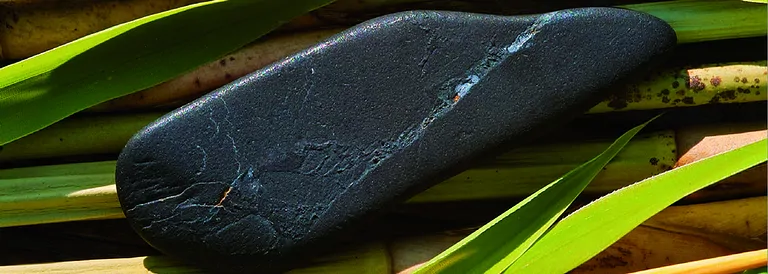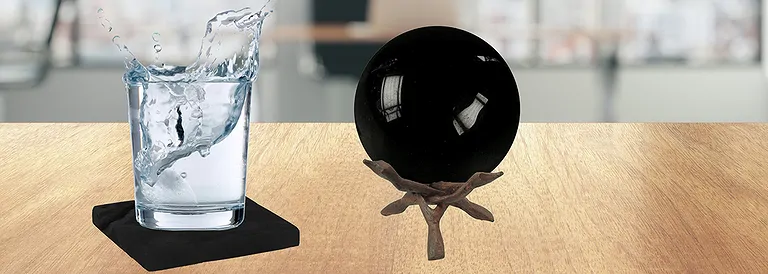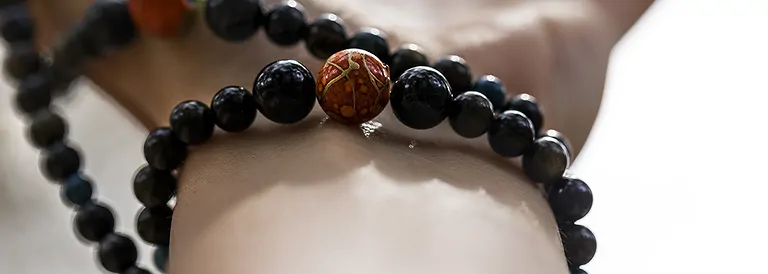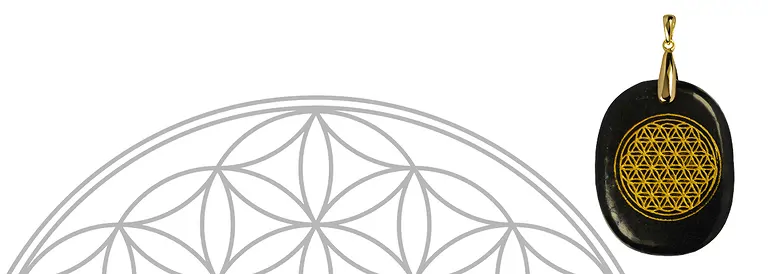
Shungite - Meaning and bearing of a newcomer
Shungite accompanies us through turbulent time by its balancing and stabilizing effect. Old, outdated habits can be stripped off like an old skin and left behind. Without hesitation we can devote ourselves completely to today and tomorrow and realize our personal wishes and ideas. What turns out to be successful now will also enable us to have a materially stable good basis in the long run.
Mineralogical profile of Shungite
Chemical Formula: Elemental Carbon (C)
Mineral class: Natural elements
Formation: Sedimentary coal rock, is formed by the incarbonation of algae in the digested sludge and is therefore also known as "algal coal"
Color, luster: Black, greasy, resinous, and sometimes almost metallic luster, dull as rock, often stains.
Crystal system: amorphous
Mohs hardness: 3.5 to 4
Cleavability: No splitability, conchoidal or granular-uneven fracture
Localities, main supply countries: Shun'ga region in Russia (Lake Onega in Karelia and at Lake Ladoga) and eastern Finland. Other places of discovery are Spain (Leon region) and India. Schungite is mostly found in areas, where oil shale also occurs. The schungite available in the trade as rough stones, Tumbled Stones, jewelry, etc. comes almost exclusively from the Shun'ga region, which also gave the schungite its name.

Appearance: Dark, compact coal in dense masses, very light and partly highly lustrous in almost pure state. Rather fine-grained dark gray than schungite-bearing claystone, partly with recognizable fine sedimentary layers.
Use: Shungite is used as a color pigment and is used as a substitute for activated carbon in filters. However, the latter is controversial, since the release of harmful hydrocarbons can not be ruled out, which is also with the use of shungite as a water stone (see below) to be considered.
Synonyms: schungite, schungite charcoal, inostranzeff'sches schungite, algae charcoal
Shungite as tumbled stone, stinged bead, donut, pyramide and much more at wholesale prices
Shungite as stone for gemstone water
When preparing shungite water the initiation method or the test tube method, for example, with a Vitalstick, is the only useful production methods, because so no direct contact between the shungite stone and the water is given. Also well suited is the energizing of the water with the help of a shungite plate, on which the pitcher or the glass are placed.

Applications of shungite in gemstone healing
Shungite pyramids, spheres, plates and cubes of shungite have an energizing effect on working, living and sleeping areas. In addition to the energetic and decorative effect, objects made of shungite are often used as compensation against electromagnetic radiation and placed next to computers or laptops.
Pyramids, spheres, plates, cuboids and cubes made of shungite are applied to energize working, living and sleeping areas. In addition to the energetic and decorative effect, objects made of shungite are often used as compensation against electromagnetic radiation and are placed next to computers or laptops. As a healing and jewelry stone, shungite is available in many varieties, for example, as a pendant, necklace, amulet, pocket stone, as a bracelet or gemstone mala. Shungite acts especially on the first, the root chakra. In astrology shungite is assigned to Saturn and Capricorn.
In industry, shungite is used, for example, as a color pigment, for the production of car tires and as a filler of filters.
Gemstone malas, spheres, cubes, hearts, pyramids and more shungite items at wholesale prices

Very special: nobel Shungite
Characteristic of the nobel shungite are the metallic luster, the conchoidal fracture and the extremely high carbon content. Only about 1% of the total shungite occurrence consists of nobel shungite. This occurs in maximum 40cm wide bands and must be must be mined laboriously by hand underground. Occasionally, reddish-brownish inclusions can be seen in the noble shungite; this is jarosite, an iron sulfate formed by oxidation of Pyrite.
Little sister, big brother of Shungite: coal, anthracite, jett
